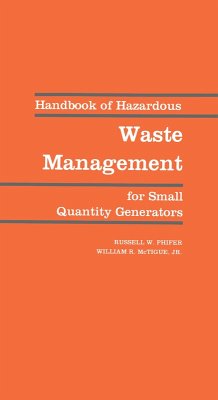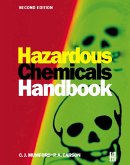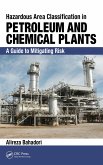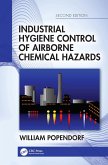Handbook of Hazardous Waste Management for Small Quantity Generators (eBook, PDF)


Alle Infos zum eBook verschenken

Handbook of Hazardous Waste Management for Small Quantity Generators (eBook, PDF)
- Format: PDF
- Merkliste
- Auf die Merkliste
- Bewerten Bewerten
- Teilen
- Produkt teilen
- Produkterinnerung
- Produkterinnerung

Hier können Sie sich einloggen

Bitte loggen Sie sich zunächst in Ihr Kundenkonto ein oder registrieren Sie sich bei bücher.de, um das eBook-Abo tolino select nutzen zu können.
Special features of this book include: practical "how to" instructions, state/federal regulations-plus overview, lab waste management, interpretations of regulations, enforcement, generator checklist, and complete coverage. This handbook is an excellent resource for hazardous waste managers, safety managers, lab managers, occupational health/safety workers, hazardous waste brokers, and small business managers. Disposal facilities, trade associations, consultants, administrators, attorneys, unions, and industrial hygienists will find this practical guide useful as well.
- Geräte: PC
- mit Kopierschutz
- eBook Hilfe
![Handbook of Hazardous Waste Management for Small Quantity Generators (eBook, ePUB) Handbook of Hazardous Waste Management for Small Quantity Generators (eBook, ePUB)]() Russell W. PhiferHandbook of Hazardous Waste Management for Small Quantity Generators (eBook, ePUB)256,95 €
Russell W. PhiferHandbook of Hazardous Waste Management for Small Quantity Generators (eBook, ePUB)256,95 €![Remediation of Legacy Hazardous and Nuclear Industrial Sites (eBook, PDF) Remediation of Legacy Hazardous and Nuclear Industrial Sites (eBook, PDF)]() Remediation of Legacy Hazardous and Nuclear Industrial Sites (eBook, PDF)73,95 €
Remediation of Legacy Hazardous and Nuclear Industrial Sites (eBook, PDF)73,95 €![Protecting Personnel at Hazardous Waste Sites (eBook, PDF) Protecting Personnel at Hazardous Waste Sites (eBook, PDF)]() William MartinProtecting Personnel at Hazardous Waste Sites (eBook, PDF)108,95 €
William MartinProtecting Personnel at Hazardous Waste Sites (eBook, PDF)108,95 €![Management of Hazardous Energy (eBook, PDF) Management of Hazardous Energy (eBook, PDF)]() Thomas Neil McManusManagement of Hazardous Energy (eBook, PDF)57,95 €
Thomas Neil McManusManagement of Hazardous Energy (eBook, PDF)57,95 €![Hazardous Chemicals Handbook (eBook, PDF) Hazardous Chemicals Handbook (eBook, PDF)]() P A CarsonHazardous Chemicals Handbook (eBook, PDF)86,95 €
P A CarsonHazardous Chemicals Handbook (eBook, PDF)86,95 €![Hazardous Area Classification in Petroleum and Chemical Plants (eBook, PDF) Hazardous Area Classification in Petroleum and Chemical Plants (eBook, PDF)]() Alireza BahadoriHazardous Area Classification in Petroleum and Chemical Plants (eBook, PDF)81,95 €
Alireza BahadoriHazardous Area Classification in Petroleum and Chemical Plants (eBook, PDF)81,95 €![Industrial Hygiene Control of Airborne Chemical Hazards, Second Edition (eBook, PDF) Industrial Hygiene Control of Airborne Chemical Hazards, Second Edition (eBook, PDF)]() William PopendorfIndustrial Hygiene Control of Airborne Chemical Hazards, Second Edition (eBook, PDF)45,95 €
William PopendorfIndustrial Hygiene Control of Airborne Chemical Hazards, Second Edition (eBook, PDF)45,95 €-
-
-
Dieser Download kann aus rechtlichen Gründen nur mit Rechnungsadresse in A, B, BG, CY, CZ, D, DK, EW, E, FIN, F, GR, HR, H, IRL, I, LT, L, LR, M, NL, PL, P, R, S, SLO, SK ausgeliefert werden.
- Produktdetails
- Verlag: Taylor & Francis eBooks
- Seitenzahl: 216
- Erscheinungstermin: 26. August 2020
- Englisch
- ISBN-13: 9781000114669
- Artikelnr.: 60062320
- Verlag: Taylor & Francis eBooks
- Seitenzahl: 216
- Erscheinungstermin: 26. August 2020
- Englisch
- ISBN-13: 9781000114669
- Artikelnr.: 60062320
- Herstellerkennzeichnung Die Herstellerinformationen sind derzeit nicht verfügbar.
List of Tables
1 WHY YOU NEED THIS BOOK
2 INTRODUCTION TO THE REGULATIONS
The Regulatory Scheme
Federal Legislation
EPA Regulations
State Authorization of RCRA Programs
Responsibilities of the Small Quantity Generator
Determination of Jurisdiction
Determining Quantity of Waste Generated
Hazardous Waste Determination
Understanding Definitions and Exclusions
Evaluation of Nonexcluded Wastes
EPA Lists of Hazardous Wastes
EPA Characteristics of Hazardous Waste
3 TYPES OF WASTE GENERATED BY SMALL QUANTITY GENERATORS
Types of Small Quantity Generators
Waste Streams of Small Generators
Waste Types ,
Solvents
Acids and Bases
Heavy Metals
Pesticides
Reactives
Chemical Reagents
Plating and Heat Treating Wastes
4 GENERATOR REQUIREMENTS
Conditionally Exempt Generators
Required Actions
Maintaining Conditionally Exempt Status
Small Quantity Generators
Notification
Definition
Process
Updating the EPA
Eligible Recipients of Waste
The Hazardous Waste Manifest
When to Use
Types
Acquisition
Number of Required Copies
Retention
Submission of the Completed Manifest
Proper Completion
Pretransport Requirements
Activities Required by U.S. DOT
Accumulation Time
Preparedness and Prevention
Contingency Procedures
Recordkeeping and Reporting
USING THE CODE OF FEDERAL REGULATIONS (TITLES 40 AND 49)
Basis for the Regulations
Federal Regulations
State Regulations
Organization of the Regulations
Supplementary Information
Edition Dates
Authority
Federal Register References
Notes and Comments
Obsolete Provisions
Other Information
6 ON
SITE STORAGE AND HANDLING OF HAZARDOUS WASTES
Facets of On
Site Waste Management
Storage of Hazardous Waste
Compatibility in Storage
Packaging of Hazardous Wastes
Containers
Proper Labeling
Regulatory Compliance
Segregation of Wastes in Storage
Ventilation
Climate /Environment :
Space
Economics
Choosing a Waste Management Company
Effect on Management Methods
7 LIMITING LIABILITIES
Internal Environmental Audits
Purpose
Audit Follow
up
Choosing Hazardous Waste Management Companies
Transporters
Permits
Vehicles
References
Experience
Personnel
Insurance
Financial Stability
Lead Time
Cost
Waste Brokers
Experience
Personnel
Cost
Disposal Facilities
Location
Materials Handled
Permits
Notices of Violation
Financial Stability
Personnel
Insurance
Approval Process
Costs
8 ENFORCEMENT
Inspecting Agencies
What State Inspectors Look For
Ensuring Successful Inspections
9 LABORATORY WASTE MANAGEMENT
Labpacks
Disposal in Municipal Systems
Facets of Management
Program Administration
The Waste Manager
Training
Inventory Analysis and Control
On
Site Treatment and Disposal
Storage, Packaging, and Labeling
Off
Site Disposal Method Selection
10 DISPOSAL OPTIONS
Thermal Treatment
Incineration
Detonation
Pyrolysis
Open Burning
Chemical Treatment
Acid /Base Neutralization
Carbon Absorption
Ion Exchange
Oxidation /Reduction
Precipitation /Clarification
Biological Treatment
Microorganisms
Microbial Breakdown
Landfarming
Land Disposal
Secure Chemical Landfilling
Deepwell Injection
Surface lmpoundment ;
Disposal Method Selection
11 TRENDS IN HAZARDOUS WASTE MANAGEMENT
Political Aspects
Land Disposal: An Interim Step in Disposal Technology
Mobile and On
Site Treatment Advances
Research Funding
Additional Waste Listings and Delistings
Waste Minimization
Greater Focus on Nonhazardous Wastes (Solid Waste)
NIMBY Syndrome: A Challenge for Society
APPENDICES
I Hazardous Waste Agencies and Small Quantity Limits
II Materials Which Are Not Solid Wastes
III Solid Wastes Which Are Not Hazardous Wastes
IV Listed Hazardous Wastes
V Table 1
Maximum Concentration of Contaminants for Characteristic of EP Toxicity
VI Instructions for Completing the Uniform Hazardous Waste Manifest
VII U.S. DOT Hazardous Materials Definitions
VIII Preparedness and Prevention
IX Contingency Procedures
X Guide for Reuse of Packagings (Boxes, Kegs, Cylinders and Steel Drums)
XI Federal Regulation ( 40 CFR 261.7) Regarding Hazardous Waste Residues in Empty Containers
Index.
List of Tables
1 WHY YOU NEED THIS BOOK
2 INTRODUCTION TO THE REGULATIONS
The Regulatory Scheme
Federal Legislation
EPA Regulations
State Authorization of RCRA Programs
Responsibilities of the Small Quantity Generator
Determination of Jurisdiction
Determining Quantity of Waste Generated
Hazardous Waste Determination
Understanding Definitions and Exclusions
Evaluation of Nonexcluded Wastes
EPA Lists of Hazardous Wastes
EPA Characteristics of Hazardous Waste
3 TYPES OF WASTE GENERATED BY SMALL QUANTITY GENERATORS
Types of Small Quantity Generators
Waste Streams of Small Generators
Waste Types ,
Solvents
Acids and Bases
Heavy Metals
Pesticides
Reactives
Chemical Reagents
Plating and Heat Treating Wastes
4 GENERATOR REQUIREMENTS
Conditionally Exempt Generators
Required Actions
Maintaining Conditionally Exempt Status
Small Quantity Generators
Notification
Definition
Process
Updating the EPA
Eligible Recipients of Waste
The Hazardous Waste Manifest
When to Use
Types
Acquisition
Number of Required Copies
Retention
Submission of the Completed Manifest
Proper Completion
Pretransport Requirements
Activities Required by U.S. DOT
Accumulation Time
Preparedness and Prevention
Contingency Procedures
Recordkeeping and Reporting
USING THE CODE OF FEDERAL REGULATIONS (TITLES 40 AND 49)
Basis for the Regulations
Federal Regulations
State Regulations
Organization of the Regulations
Supplementary Information
Edition Dates
Authority
Federal Register References
Notes and Comments
Obsolete Provisions
Other Information
6 ON
SITE STORAGE AND HANDLING OF HAZARDOUS WASTES
Facets of On
Site Waste Management
Storage of Hazardous Waste
Compatibility in Storage
Packaging of Hazardous Wastes
Containers
Proper Labeling
Regulatory Compliance
Segregation of Wastes in Storage
Ventilation
Climate /Environment :
Space
Economics
Choosing a Waste Management Company
Effect on Management Methods
7 LIMITING LIABILITIES
Internal Environmental Audits
Purpose
Audit Follow
up
Choosing Hazardous Waste Management Companies
Transporters
Permits
Vehicles
References
Experience
Personnel
Insurance
Financial Stability
Lead Time
Cost
Waste Brokers
Experience
Personnel
Cost
Disposal Facilities
Location
Materials Handled
Permits
Notices of Violation
Financial Stability
Personnel
Insurance
Approval Process
Costs
8 ENFORCEMENT
Inspecting Agencies
What State Inspectors Look For
Ensuring Successful Inspections
9 LABORATORY WASTE MANAGEMENT
Labpacks
Disposal in Municipal Systems
Facets of Management
Program Administration
The Waste Manager
Training
Inventory Analysis and Control
On
Site Treatment and Disposal
Storage, Packaging, and Labeling
Off
Site Disposal Method Selection
10 DISPOSAL OPTIONS
Thermal Treatment
Incineration
Detonation
Pyrolysis
Open Burning
Chemical Treatment
Acid /Base Neutralization
Carbon Absorption
Ion Exchange
Oxidation /Reduction
Precipitation /Clarification
Biological Treatment
Microorganisms
Microbial Breakdown
Landfarming
Land Disposal
Secure Chemical Landfilling
Deepwell Injection
Surface lmpoundment ;
Disposal Method Selection
11 TRENDS IN HAZARDOUS WASTE MANAGEMENT
Political Aspects
Land Disposal: An Interim Step in Disposal Technology
Mobile and On
Site Treatment Advances
Research Funding
Additional Waste Listings and Delistings
Waste Minimization
Greater Focus on Nonhazardous Wastes (Solid Waste)
NIMBY Syndrome: A Challenge for Society
APPENDICES
I Hazardous Waste Agencies and Small Quantity Limits
II Materials Which Are Not Solid Wastes
III Solid Wastes Which Are Not Hazardous Wastes
IV Listed Hazardous Wastes
V Table 1
Maximum Concentration of Contaminants for Characteristic of EP Toxicity
VI Instructions for Completing the Uniform Hazardous Waste Manifest
VII U.S. DOT Hazardous Materials Definitions
VIII Preparedness and Prevention
IX Contingency Procedures
X Guide for Reuse of Packagings (Boxes, Kegs, Cylinders and Steel Drums)
XI Federal Regulation ( 40 CFR 261.7) Regarding Hazardous Waste Residues in Empty Containers
Index.







